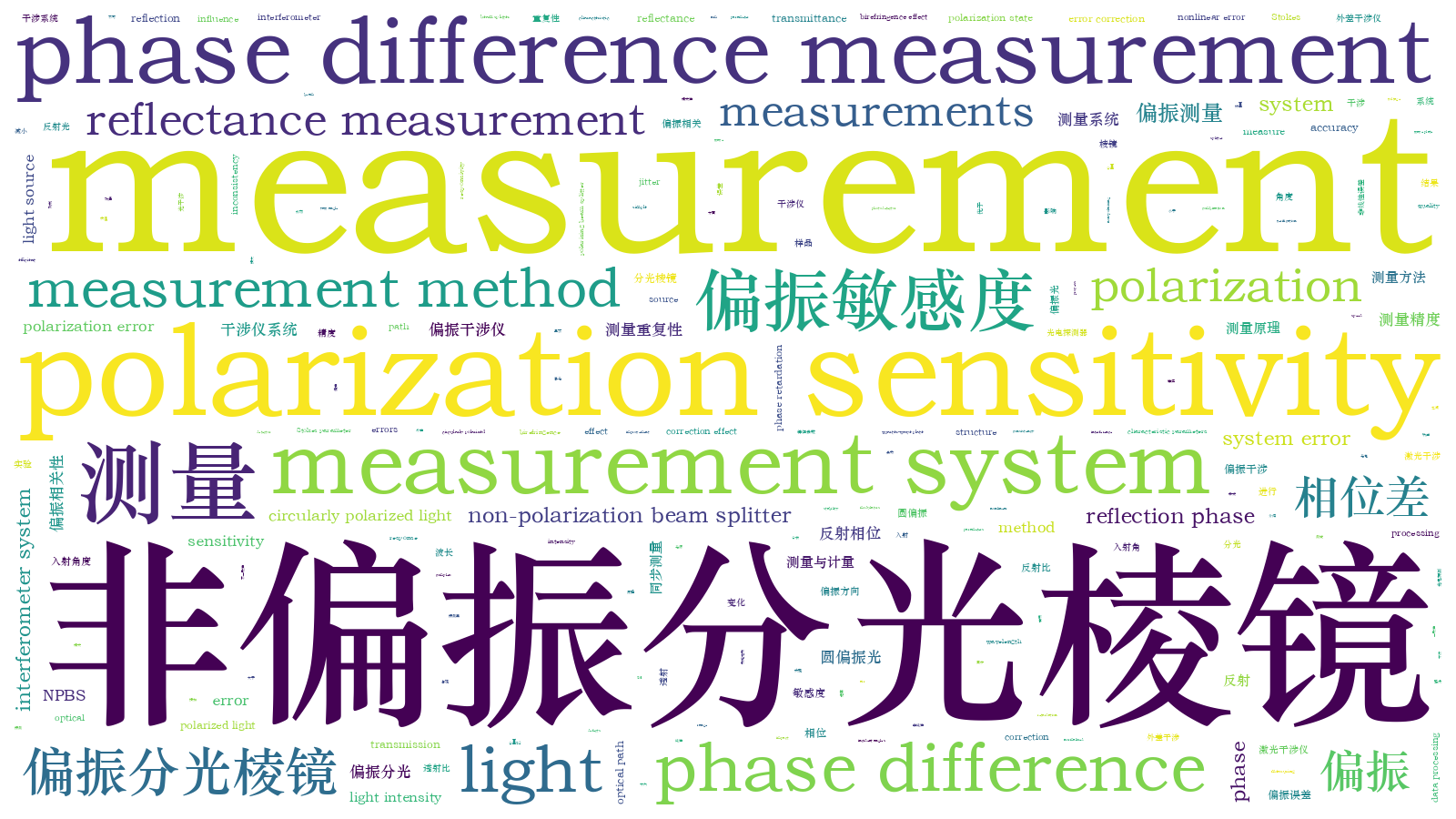非偏振分光棱镜的偏振敏感度测量  下载: 505次
下载: 505次
A non-polarizing beam splitter (NPBS) is commonly used in interferometer systems. Ideally, the NPBS can ensure consistency between the polarization state of the outgoing light and that of the incident light. However, because of defects in the actual process, the birefringence effect of NPBS has a non-negligible impact on the nonlinear error, polarization error, and measurement accuracy of the interference system. Therefore, it is necessary to measure the polarization sensitivity of an NPBS to compensate for the birefringence error. At present, the general system structure used to measure polarization sensitivity is relatively complex, and some methods require a combination of spectrometers or modulators and additional circuitry for measurement, which is cumbersome with respect to data processing and inconvenient to operate. In this paper, we propose a different method to measure the polarization sensitivity of NPBS, which has the advantages of fast measurement speed, simple system structure, efficient data processing, high repeatability, and can eliminate the influence of light source jitter, optical path system error, and PD responsivity inconsistency. This method is significant for evaluating the NPBS error to provide high-quality NPBSs for use in interferometer systems.
NPBS polarization sensitivity measurements include transmittance/reflectance measurement and transmission/reflection phase difference measurement. First, the measurement principles of the four characteristic parameters affecting the polarization sensitivity of NPBS are introduced. Regarding transmittance/reflectance measurements, circularly polarized light is incident to the NPBS, and the intensities of the s- and p-polarization directions in the transmitted/reflected light are measured synchronously. The voltage values corresponding to the light intensity of s light and p light are obtained by photodetector. The measurement results are then normalized to suppress the influence of light source jitter, optical path system error, and PD response inconsistency on the measurement results. Regarding the phase polarization sensitivity measurement, we use a polarization measurement system (PSGA) to measure the S2 and S3 Stokes components of the transmitted/reflected light. Using the Stokes parameter method to calculate the phase difference can eliminate the effect of light intensity jitter. The relative values of the transmission/reflection phase difference of the s light and p light of the NPBS are then obtained by the difference method to eliminate the influence of the optical path system error.
The accuracy of the proposed NPBS polarization sensitivity measurement method was verified experimentally. In terms of the verification of the transmittance/reflectance polarization sensitivity measurement system, the blank transmittance in air without NPBS was measured, and the transmittance after normalization correction was 1.0001, indicating that the transmittance/reflectance polarization sensitivity measurement of the system has good accuracy (error of 0.01%). This is an improvement compared to the result before normalization correction (3.32%) and clearly demonstrates the error correction effect obtained by normalization correction (Fig. 4). To verify the transmission/reflection phase difference polarization sensitivity measurement system, the measurement system was used to measure the phase retardation of the quarter-wave plate, and the measurement result deviated by 0.09° from the theoretical value of 90°, indicating the high measurement accuracy of the measurement system (Fig. 4). The polarization sensitivities of three customized NPBS samples were measured ten times repeatedly using the proposed measurement method. The measurement accuracy of the NPBS transmittance/reflectance is -0.08%-+0.08%, and the repeatability is better than 0.1%. The measurement accuracy of the NPBS transmission/reflection phase difference is -0.84%-+0.84%, and the repeatability is better than 1% (Fig. 5). These results demonstrate that the proposed measurement method has the advantages of good measurement stability and high measurement accuracy. Furthermore, the polarization sensitivities of the NPBS samples were measured at different incident wavelengths and incident angles. Within the range of 1540 nm-1560 nm, the change in the transmittance/reflectance was less than 0.02, and the transmission/reflection phase difference between s light and p light decreased with increasing wavelength (Fig. 6). When the incident yaw angle changes from -5° to +5°, the phase difference between s light and p light decreases (Fig. 7). The change in the NPBS reflection phase difference is larger than that in the NPBS transmission phase difference, indicating that the former is more sensitive to wavelength and angle changes.
In this paper, a method for measuring the polarization sensitivity of NPBS is proposed. The transmittance and reflectance are measured by simultaneously measuring the intensities of the transmitted/reflected circularly polarized light in the s- and p-polarization directions. The light source jitter, optical path system error, and error caused by inconsistencies in the detector response are eliminated through normalization correction. By using a polarization measurement system to measure the S2 and S3 Stokes components of the transmitted/reflected light, the s light and p light transmission/reflection phase difference of the NPBS can be obtained. Based on the above method, the measurement accuracy for transmittance and reflectance is -0.08%-+0.08% and the repeatability is better than 0.1%. The measurement accuracy of the transmission phase difference and reflection phase difference is -0.84%-+0.84%, and the repeatability is better than 1%. The proposed NPBS polarization sensitivity characteristic measurement method has the advantages of simple system structure, efficient data processing, high repeatability, and can eliminate the influence of light source jitter, optical path system error, and PD responsivity inconsistency. The method is significant for analyzing and compensating for the errors caused by an NPBS to obtain high-quality interferometer systems.
孟晨, 高珊, 姚晓天, 崔省伟, 郝鹏. 非偏振分光棱镜的偏振敏感度测量[J]. 中国激光, 2023, 50(5): 0504004. Chen Meng, Shan Gao, X. Steve Yao, Shengwei Cui, Peng Hao. Polarization Sensitivity Measurement Method for Non-Polarizing Beam Splitters[J]. Chinese Journal of Lasers, 2023, 50(5): 0504004.







